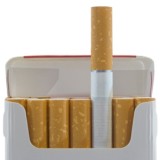From Bloomberg News – May 19, 2011
By Yuji Okada, Tsuyoshi Inajima and Shunichi Ozasa
A radiation alarm went off at Tokyo Electric Power Co.’s Fukushima nuclear power plant before the tsunami hit on March 11, suggesting that contrary to earlier assumptions the reactors were damaged by the earthquake that spawned the wall of water.
A monitoring post on the perimeter of the plant about 1.5 kilometers (1 mile) from the No. 1 reactor went off at 3:29 p.m., minutes before the station was overwhelmed by the tsunami that knocked out backup power that kept reactor cooling systems running, according to documents supplied by the company. The monitor was set to go off at high levels of radiation, an official said.
“We are still investigating whether the monitoring post was working properly,” said Teruaki Kobayashi, the company’s head of nuclear facility management. “There is a possibility that radiation leaked before the tsunami arrived.” Kobayashi said he didn’t have the exact radiation reading that would trigger the sensor.
Officials at the company, known as Tepco, had earlier said the plant stood up to the magnitude-9 quake and was crippled by the tsunami that followed, causing the world’s worst nuclear crisis since Chernobyl in 1986. The early radiation alarm has implications for other reactors in Japan, one of the most earthquake prone countries in the world, because safety upgrades ordered by the government since March 11 have focused on the threat from tsunamis.
Earthquake Risk
Many scientists have considered the possibility of damage to Fukushima reactors from the quake, said Tetsuo Ito, head of the Atomic Energy Research Institute at Kinki University in western Japan. “Utilities should reinforce safety measures at nuclear power plants, particularly ones housing old reactors like the Fukushima station.”
The company’s shares fell 8 percent today to 358 yen. They’ve fallen 83 percent since the disaster. The cost of protecting the Tepco’s debt from default rose to a record today, according to data provider CMA.
Tepco this week released thousands of pages of documents that highlight the chaos in the early hours of the disaster as workers frantically tried to prevent meltdowns in three of six reactors at Fukushima. They included pictures of whiteboards with scribbled notes of times and events.
Among the documents, the pressure and water level inside of No. 1 reactor inner vessel fluctuated after the earthquake hit at 2:46 p.m. Most of the readings for the No. 1 reactor go blank a little after 3:30 p.m. when the waves swamped the plant.
Venting Attempts
The company is still verifying the accuracy of the data, Takeo Iwamoto, a spokesman for the utility, said. Tepco submitted the documents to the Nuclear and Industrial Safety Agency on May 16 after the watchdog requested them, Iwamoto said. The files were released to the media to increase transparency, he said.
The documents show that a little after 9 a.m. on March 12, workers at the No. 1 reactor started trying to vent steam and gas as pressure in the reactor exceeded design specifications. The vent was partly opened manually at about 9:15 a.m. and attempts to get it fully opened were abandoned about 15 minutes later due to high radiation levels.
Workers in the control room then opened it by remote control, only for it to keep closing, according to the documents. A build up of hydrogen gas in the reactor building then caused an explosion that blew out part of the structure at 3:36 p.m. the same day.
Attempts to vent gas at the No. 2 and No. 3 reactors probably also failed and the pressure inside exceeded design levels for their containment vessels, the records show. Gauges in these buildings, which later were damaged by hydrogen explosions, also failed.
Instrument Blindness
Reading radiation and pressure levels was the only way to establish whether venting succeeded, Kobayashi said.
On May 15, or more than two months after the disaster at the Fukushima Dai-Ichi plant, Tepco said conditions were worse than expected in reactor No. 1 when it found all uranium fuel rods had melted.
Two workers entered the Fukushima the No. 3 reactor building to check radiation levels yesterday, the first time they’ve been in since March 14, spokesman Takeo Iwamoto said by telephone.
Yesterday it sent four workers into reactor No. 2 for the first time since March 14 to measure radiation levels and assess whether work can be done to fix gauges that will show the condition of the core.
Beside radiation leaks into the atmosphere forcing about 50,000 families near the plant to evacuate, more than 10 million liters (2.6 million gallons) of radiation-contaminated water have leaked or been released into the sea.
Millions of liters of radiated water have also filled basements and trenches at the station from leaking reactor vessels and piping.
Japan’s government in April raised the severity rating of the Fukushima crisis to the highest on an international scale, the same level as the Chernobyl disaster. The station, which has experienced hundreds of aftershocks since March 11, may release more radiation than Chernobyl before the crisis is contained, Tepco officials have said.
Read original article



